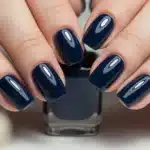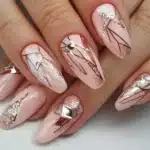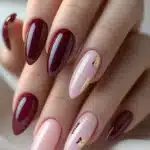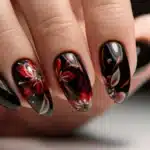In the world of hair fashion, black hair dye reigns supreme as a timeless classic. But beneath the surface of this popular trend lies a burning question: Does black hair dye damage hair?
This comprehensive guide will delve deep into the science of hair dye, debunk common myths, and provide you with expert insights to help you make informed decisions about your hair care routine.
The Science of Hair Dye
To understand the potential impact of black hair dye on your hair, we first need to explore the intricate science behind hair coloring.
Chemical Composition of Black Hair Dye
Black hair dye typically contains a complex mixture of chemicals designed to penetrate the hair shaft and deposit color. The main components include:
- Ammonia or ethanolamine: These alkaline agents open the hair cuticle, allowing the dye to penetrate the hair shaft.
- Hydrogen peroxide: This acts as a developer, removing existing color and activating the dye.
- Para-phenylenediamine (PPD) or other color molecules: These are the primary coloring agents.
- Resorcinol: This helps the color last longer and enhances the final shade.
- Conditioning agents: These help to minimize damage and improve the feel of the hair post-dyeing.
How Hair Dye Interacts with Hair Structure
Your hair is made up of three main layers:
- Cuticle: The outer protective layer composed of overlapping scales.
- Cortex: The middle layer containing melanin (natural pigment) and keratin proteins.
- Medulla: The innermost layer (not always present), which plays a minimal role in the dyeing process.
When you apply black hair dye, here’s what happens:
- The alkaline agent (ammonia or ethanolamine) opens up the cuticle, causing the scales to lift.
- Hydrogen peroxide penetrates the hair shaft, breaking down existing melanin and creating an environment for new color to develop.
- Dye molecules enter the cortex and bond with the hair’s protein structure, creating new color compounds.
- The cuticle closes, trapping the new color inside.
This process can potentially cause some damage to the hair structure, especially with repeated use. The lifting of the cuticle and the oxidation process can weaken the hair’s protein structure over time.
Debunking Common Myths
Let’s address some widespread misconceptions about black hair dye and its effects on hair health.
1-Myth: Black dye is more damaging than other colors
Truth: The level of potential damage depends more on the formulation and application process than the color itself. Black dye often requires less lifting of natural pigment compared to lighter shades, which can actually make it less damaging in some cases. However, the concentration of dye molecules in black hair color can be higher, which may lead to more dryness if not properly cared for.
2-Myth: Permanent dye always causes irreversible damage
Truth: While permanent dye does alter the hair structure, proper care and maintenance can minimize long-term damage. Using high-quality products and following a hair care routine tailored to colored hair can help maintain hair health. The key is to balance the frequency of coloring with intensive hair care practices.
3-Myth: Natural black dyes are always safer
Truth: Natural doesn’t always mean safer. Some natural dyes, like henna, can actually make it difficult to change your hair color later due to metallic salts often found in these products. Additionally, even natural dyes can cause allergic reactions in some people. It’s important to research and patch test any dye, natural or synthetic, before full application.
See Also : 45+ Stunning Prom Nail Designs for a Memorable Night
Potential Risks of Black Hair Dye
While black hair dye can give you a stunning look, it’s important to be aware of potential risks:
1-Allergic Reactions
Some people may develop allergic reactions to hair dye ingredients, particularly PPD. Symptoms to watch for include:
- Itching or burning sensation on the scalp
- Redness or swelling
- Difficulty breathing (in severe cases)
- Hives or rash on the face, neck, or other areas
Pro Tip: Always perform a patch test 48 hours before applying hair dye to check for potential allergic reactions. Apply a small amount of the dye mixture behind your ear or on the inside of your elbow.
2-Scalp Irritation
The chemicals in hair dye can sometimes irritate the scalp, leading to:
- Dryness and flaking
- Temporary hair loss
- Scalp sensitivity
- Increased dandruff-like symptoms
3-Hair Porosity Changes
Repeated dyeing can alter your hair’s porosity, affecting how well it absorbs and retains moisture. This can lead to:
- Dryness and brittleness
- Increased frizz
- Difficulty in maintaining color vibrancy
- Uneven color absorption in future dye applications
You might like reading this article : 35 Stiletto Nail Designs That Will Elevate Your Style
Factors Affecting Hair Damage
The extent of potential damage from black hair dye depends on several factors:
- Hair type and condition: Fine or already damaged hair may be more susceptible to dye-related damage. Coarse or thick hair might be more resilient but could require stronger formulations for effective coloring.
- Frequency of dyeing: More frequent applications increase the risk of damage. Ideally, wait at least 4-6 weeks between full dye applications.
- Application method: Improper application can lead to uneven results and increased damage. This includes leaving the dye on for too long or not distributing it evenly throughout the hair.
- Quality of products used: High-quality dyes and aftercare products can help minimize damage. Professional-grade products often contain more nourishing ingredients and less harsh chemicals.
- Pre-existing hair treatments: If your hair has been chemically treated (e.g., permed, relaxed, or bleached), it may be more vulnerable to damage from dye.
- Overall hair care routine: Regular use of heat styling tools, exposure to sun and chlorine, and lack of proper moisturizing can compound the effects of hair dye.
Long-term Effects of Black Hair Dye
Understanding the potential long-term effects of using black hair dye can help you make informed decisions about your hair care routine.
Hair Texture Changes
Regular use of black hair dye may lead to:
- Coarser texture due to the lifting of the cuticle
- Increased dryness from the loss of natural oils
- Loss of natural shine as the cuticle becomes more damaged
- Potential for increased tangling and matting
Elasticity and Strength
The chemical processes involved in dyeing can affect your hair’s:
- Ability to stretch without breaking (elasticity)
- Overall strength and resilience
- Resistance to breakage and split ends
Over time, these changes can lead to:
- Increased hair breakage
- More visible split ends
- Difficulty in growing hair longer
Color Fading and Maintenance
Black hair dye tends to fade over time, which may result in:
- Brassy or reddish undertones, especially in sunlight
- Need for frequent touch-ups, particularly for gray coverage
- Potential build-up of color, leading to an unnatural, flat appearance
To combat these issues:
- Use color-safe, sulfate-free shampoos
- Limit washing to 2-3 times a week
- Use cool water when rinsing to help seal the cuticle
- Apply a UV-protectant spray to minimize sun-induced fading
Minimizing Damage: Best Practices
To keep your hair healthy while enjoying the bold look of black hair dye, follow these best practices:
Proper Preparation Techniques
- Perform a strand test to check for potential reactions and to see how your hair responds to the dye.
- Avoid washing your hair for 1-2 days before dyeing to allow natural oils to protect your scalp.
- Apply a barrier cream around your hairline to prevent skin staining.
- Conduct a thorough hair assessment to identify any weak or damaged areas that may need extra care.
Choosing the Right Products
Select products that are:
- Ammonia-free or low-ammonia to minimize cuticle damage
- Specifically formulated for colored hair to maintain vibrancy
- Rich in nourishing ingredients like keratin, argan oil, or botanical extracts
- pH-balanced to help keep the cuticle sealed
Consider options like:
- Demi-permanent dyes for less commitment and reduced damage
- Professional salon treatments for more even application and expert care
Aftercare and Maintenance Tips
- Wait at least 48 hours before washing your hair after dyeing to allow the color to set.
- Use color-safe, sulfate-free shampoos and conditioners to prevent stripping.
- Apply a deep conditioning treatment weekly to restore moisture and protein balance.
- Limit heat styling and always use heat protectant products when you do style.
- Use a silk or satin pillowcase to reduce friction and color fade while sleeping.
- Consider a color-depositing conditioner to maintain richness between dye sessions.
Explore this interesting article : 30 Stunning Orange Nail Designs to Brighten Your Day
Alternatives to Traditional Black Hair Dye
If you’re concerned about potential damage, consider these alternatives:
Semi-permanent Options
- Deposit color without penetrating the hair shaft deeply
- Gradually fade over 4-6 weeks, allowing for more frequent color changes
- Gentler on hair but may not cover gray as effectively
- Often contain conditioning agents that can improve hair texture
Henna and Other Natural Dyes
- Derived from plants like henna, indigo, or walnut husks
- Can strengthen hair and add shine due to their coating effect
- May be difficult to remove or change later, so commitment is key
- Require longer application times but often result in richer, more multi-dimensional color
Hair Glosses and Toners
- Add shine and temporarily enhance color
- Less damaging than permanent dye
- Ideal for refreshing existing color or neutralizing unwanted tones
- Can be used between dye sessions to extend the life of your color
Professional vs. At-home Application
When deciding between professional and at-home hair dyeing, consider the following:
| Factor | Professional | At-home |
| Cost | Higher initial cost | Lower initial cost, but may require more frequent touch-ups |
| Expertise | Professional knowledge and experience | Requires personal skill and research |
| Time | Appointment required | Can be done at your convenience |
| Results | Often more even and long-lasting | May be less consistent, especially for beginners |
| Safety | Lower risk of mishaps | Higher risk of staining or uneven application |
| Customization | Can create custom color blends | Limited to available boxed shades |
| Aftercare advice | Professional recommendations | Self-research required |
Removing Black Hair Dye
Removing black hair dye can be challenging due to its intense pigmentation. Here are some safe removal methods:
- Color remover: Specifically designed to remove artificial pigments without bleaching
- Pros: Effective on most dyes
- Cons: Can be drying to hair
- Clarifying shampoo: Can help fade color over time
- Pros: Gentle, can be used regularly
- Cons: Slow process, may not fully remove color
- Vitamin C treatment: Mix vitamin C powder with shampoo for a gentle lightening effect
- Pros: Natural and less damaging
- Cons: May not be effective on all dye types
- Professional color correction: Salon treatment for stubborn or difficult cases
- Pros: Customized approach, expert application
- Cons: Can be expensive, may require multiple sessions
Caution: Avoid harsh bleaching methods, as they can severely damage your hair. Always consult a professional if you’re unsure about the best removal method for your hair type and condition.
Special Considerations
Gray Hair Coverage
Black dye can provide excellent gray coverage, but consider:
- More frequent root touch-ups may be necessary
- A demi-permanent dye might be gentler for frequent applications
- Consider leaving some gray for a natural, dimensional look
- Use a pre-color treatment to ensure even coverage on resistant grays
Bleached or Previously Colored Hair
- May require a filler to ensure even color distribution
- Higher risk of damage due to previous chemical treatments
- Consider a protein treatment before dyeing to strengthen hair
- Might need multiple sessions to achieve desired depth of color
Textured or Curly Hair
- More prone to dryness, so extra moisturizing is crucial
- Consider using dyes specifically formulated for textured hair
- May require longer processing time for full penetration
- Use deep conditioning treatments regularly to maintain moisture balance
The Truth About Hair Dye and Health
Current Research on Cancer Risks
While early studies suggested a potential link between hair dye use and certain cancers, more recent research has been inconclusive. The American Cancer Society states that there’s no strong evidence of a direct link between modern hair dyes and cancer. However, some points to consider:
- Personal use of hair dye is unlikely to cause significant harm
- Professional hairdressers with long-term exposure may have slightly higher risks
- More research is needed for definitive conclusions
Environmental Impact of Hair Dyes
Some hair dye chemicals can have negative environmental effects:
- Water pollution from rinsing dye down the drain
- Packaging waste from single-use bottles and tubes
- Potential harm to aquatic life from certain dye ingredients
To minimize your environmental impact:
- Choose eco-friendly brands that use less harmful ingredients
- Participate in salon recycling programs for dye packaging
- Consider extending time between colorings to reduce overall usage
Regulations and Safety Standards
In the United States, the FDA regulates hair dyes as cosmetics. However, they do not approve individual hair dye products before they go on the market. Key points:
- Manufacturers are responsible for ensuring product safety
- Certain coal-tar dyes are banned due to safety concerns
- The EU has stricter regulations on hair dye ingredients
Always check ingredient lists and follow usage instructions carefully. If you experience any adverse reactions, discontinue use immediately and consult a healthcare professional.
Expert Opinions
To provide a well-rounded perspective, let’s consider insights from various experts:
Trichologist Insights
Dr. Jane Smith, a certified trichologist, says:
“While black hair dye can potentially cause some damage, the key is in how you care for your hair before, during, and after the dyeing process. With proper care, many people can maintain healthy hair while enjoying the benefits of color. It’s crucial to assess your hair’s condition regularly and adjust your care routine accordingly.”
Dr. Smith recommends:
See also : 14 Amazing Nails Colors Guide for Burgundy Dress
Hairstylist Recommendations
Master colorist John Doe advises:
- “Always have a consultation before dyeing your hair black, especially if you’re making a dramatic change. This allows for proper planning and expectation setting.”
- “Consider your natural hair color and skin tone when choosing the right shade of black. Not all blacks are created equal, and finding the right tone can make a significant difference in your overall look.”
- “Be prepared for the maintenance required to keep your black hair looking its best. This includes using the right products and scheduling regular touch-ups.”
Doe’s tips for maintaining black hair color:
- Use a color-depositing shampoo once a week to refresh the tone
- Apply a heat protectant before any thermal styling to prevent color fade
- Get regular trims to prevent split ends, which can make color look dull
Dermatologist Perspectives
Dr. Sarah Johnson, a board-certified dermatologist, notes:
“While allergic reactions to hair dye are relatively rare, they can be serious. Always perform a patch test, even if you’ve used the product before, as sensitivities can develop over time. If you experience any irritation or allergic symptoms, seek medical attention immediately.”
Dr. Johnson’s advice for minimizing skin reactions:
- Apply a thin layer of petroleum jelly around the hairline to prevent skin staining
- Avoid dyeing if you have any open cuts or abrasions on your scalp
- If you have sensitive skin, consider using a dye formulated for sensitive scalps
FAQs
Q: How often can I safely dye my hair black? A: Generally, it’s best to wait 4-6 weeks between full dye applications. Touch up roots every 2-3 weeks if needed. However, this can vary based on your hair’s health and growth rate.
Q: Can black hair dye cause hair loss? A: While extreme cases of chemical damage can lead to hair loss, normal use of hair dye typically doesn’t cause significant hair loss. However, if you notice increased shedding, consult a professional. Temporary shedding can occur due to the stress of the dyeing process, but this should subside.
Q: Is it safe to use black hair dye during pregnancy? A: While research is limited, many doctors recommend avoiding hair dye during the first trimester. After that, semi-permanent dyes or highlighting techniques that don’t touch the scalp may be safer options. Always consult your healthcare provider for personalized advice.
Conclusion
Black hair dye, when used responsibly and with proper care, can be a fantastic way to transform your look. While it’s true that any chemical process can potentially cause some level of damage to your hair, the key lies in informed decision-making and diligent hair care practices.
Remember:
- Choose high-quality products suitable for your hair type and condition
- Follow proper application and aftercare techniques
- Consider alternatives if you’re concerned about damage
- Always prioritize the health of your hair and scalp
- Regular assessments and adjustments to your hair care routine are crucial
Sarah Williams is an experienced blogger and fashion enthusiast at Glammer Galaxy. With a passion for beauty and style, she shares expert insights on hair trends, nail art, and fashion tips. Her creative flair and years of experience make her a go-to source for all things glam!

